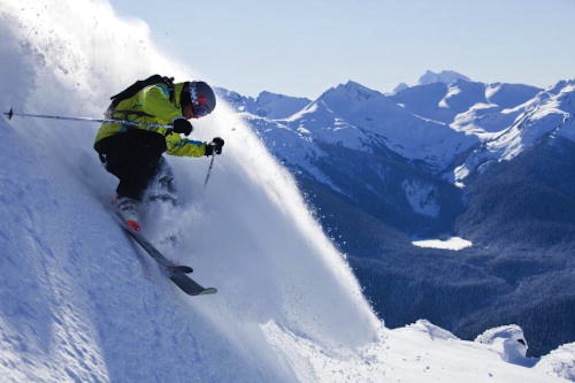
We’re very fortunate to live in an age with technological advances in gear that allow us to link turns early on, float through powder and to ski fast. When deciding how to choose downhill skis, there are many factors to keep in mind. Poorly fit skis can lead to injury, so take some time to educate yourself on the various types of skiing, skis and sizes. Check it out…
Downhill Skiing
First, determine what type of terrain you will be skiing most. Trails only? Woods? Open powder fields? Most downhill skis can be used on any type of terrain, but they will preform best on the specific type of terrain for which they were designed.
- Alpine – The majority of downhill skiers and skis will fall under the Alpine category, which consists of groomed runs with varying levels of difficulty. Basically, any run at a resort is considered Alpine skiing.
- Sidecountry – Sidecountry terrain sits just outside the groomed runs at a resort. It’s lift-accessible, unmarked terrain that is often marked by a small gate where skiers are somewhat on their own. It may or may not be patrolled, depending on how far away the skiers stray from the resort or groomed runs. One may have to hike to get back to the lifts at the base.
- Backcountry – With no lifts, no snowcats, no patrol and no lodges, the backcountry is the real deal and appeals to expert skiers and outdoorsmen. The terrain can be unstable with avalanche potential, so it’s critical to be prepared and to be knowledgeable of backcountry safety. Backcountry skiing is also where skiers will find untouched powder, no crowds and a what some may argue is a life changing experience.
Skiing Styles
Next, you’ll want to consider what type of skiing best describes your style. Do you like to primarily carve and go fast? Do you prefer to take your time and ‘cruise’ groomers? Or do you like jumps and moguls? Again, there is some crossover with ski styles. If you like to a bit of everything look for an all-mountain Alpine ski.
- Alpine – Resort skiing with groomed runs best describes alpine skiing. Skiiers heels remain locked into the skis at all times. The majority of skiers, especially beginners, fall into this category. Serious skiers always have a pair of alpine skis and often have a second or third pair from one of the styles below.
- Backcountry – Backcountry consists of rugged terrain with no marked trails or lifts. Skiiers often must hike or be dropped off by a helicopter to get to the backcountry. Once at a desired peak, they can drop into chutes, tree runs or powder fields. Randonee or alpine touring (AT) skiing has a binding system where the heel can unlock for ascending slopes with skins on the base of the skis. Once the skier is ready to drop back down the mountain, the heel is locked back into place for backcountry skiing. Telemark skiing uses a free heel technique for ascending and descending. Telemark skis are popular on groomed runs as well.
- Park and Pipe – Manmade snow structures, jumps and obstacles make up park and pipe. Skiiers preform aerial maneuvers and tricks on park and pipe specific skis.
- Freeride – Freeriding utilizes a mountain’s natural features, like a wind lip or a cliff. Skiiers jump or launch themselves from such features often performing tricks in the air. Freeriding is sometimes referred to as “big mountain skiing.”
- Freestyle – Freestyle skiing generally consists of mogul skiing combined with aerials, often performed in a competitive environment. However, freestyle skiing does cross over into terrain park skiing or performing tricks on powder.
Ski Length
The general rule of thumb when sizing skis is to stand the ski upright on the ground and the tip should touch somewhere between your nose and your eyebrows. There are a few exceptions, however. Longer skis help heavier skiers or big mountain skiers to “float” over the snow, while shorter skis help lightweight skiers, like kids, to maintain balance and control. For novice skiers, err on the shorter side. They’ll be much easier to initiate and link turns, thereby allowing newbies to pick up skiing much faster. In general, the more length you add to your ski, the faster it will go and the larger your turns will be. For tight trees or twisty runs, shorter skis will be easier to maneuver.
Ski Camber and Rocker
Camber is the traditional shape for skis where a slight arching upward curve with the bend or curve upward in the middle. Camber provides excellent turn initiation and handling on on-piste slopes. Rocker is sometimes known as reverse camber and is the exact opposite of camber. Rocker skis offer superior float in the powder and are now used all over the mountain. Rocker is no longer just for powder or park.
Types of Skis
In comparing different types of skis, consider how you will use them most. It is more common these days to own several pairs of skis for different types of terrain. For beginners or those who go out a couple times a year, stick to an all-mountin ski for the most versatility. Let’s break down the different types of skis a little further…
- All-Mountain – This is your best “do everything” ski that will perform well on groomed and powder runs alike. It’s an easy to turn ski with great edge hold.
- All-Mountain Wide – Still a ski that can go anywhere, but all-mountain wide skis are just at home in backcountry powder as they are on groomers. If you spend a fair amount of time ducking ropes to find powder, but you’re not a weekly backcountry skier, then all-mountian wides will be your best choice. For days when the woods aren’t so hot, these skis will also excel on groomed runs.
- Powder – Save your powder skis for…um…powder days! This would be a second or third ski for most owners. They perform best in light, fluffy powder. However, if you end up spending half the day on groomed trails, the won’t let you down.
- Backcountry (Randonee or Telemark) – Ligher than alpine skis, backcountry skis are best for out of bounds, no lift access excursions. They will excel in powder and are carry well on a pack for hiking since they are so lightweight.
- Twin Tip/Freestyle – Reverse take-offs and other tricks in freestyle skiing are made possible with twin tip skis. Both ends of the ski turned upward allowing for progressive aerial maneuvers and tricks. Once thought of as a fad, twin tip skis are now made by almost every major manufacturer in the ski industry. The turned-up tail allows the skier to use less pressure to release from turns and to land safely after twisting jumps.
Long Lasting Skis
Durability should be at the top of your list when it comes to narrowing down your selection of new skis. Solid equipment that lasts and delivers year after year is essential with any sporting gear. Atomic, Salomon, K2, and Rossingol are The House’s most popular manufactures. Atomic has been in business for fifty six years and continues to deliver great products to meet the demands of all skiers. Salomon is one of the most trusted and reliable brands in the industry. K2 skis are highly sought after due to their high performance, great look, and comfortable feel. Rossingol offers an amazing selection from beginner to advanced for children, ladies, and gentlemen.
Be confident in your decision and remember that any ski can technically be ridden on most terrain. Determine what type of terrain you’ll be riding most, how often you’ll be skiing and be sure to size your skis correctly. You’ll be stylin on the slopes in no time!
Now that you’re ready to choose your next pair of skis, check out these tips on keeping your skis in tip top shape.



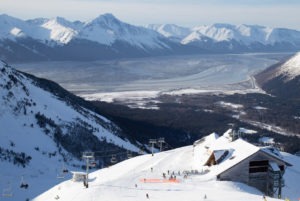
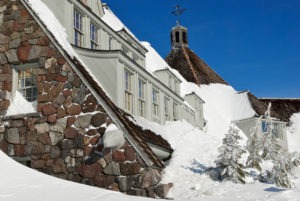
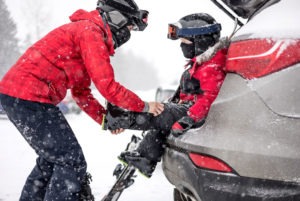
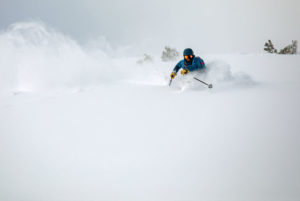
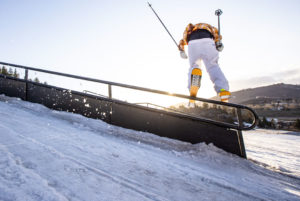
I am a lower to mid intermediate skier I have been looking at the Sierra tt1’s but I don’twant an extremely wide ski so how does this compare to a usual just alpine ski for width I have an interest in this because twin tip is a must but so is a descent price
[…] company, over the years Fischer has reached from the race gates further into the mountain. The downhill speed and GS turns can still be had by such Fischer classics, but on days when the Nastar course is […]